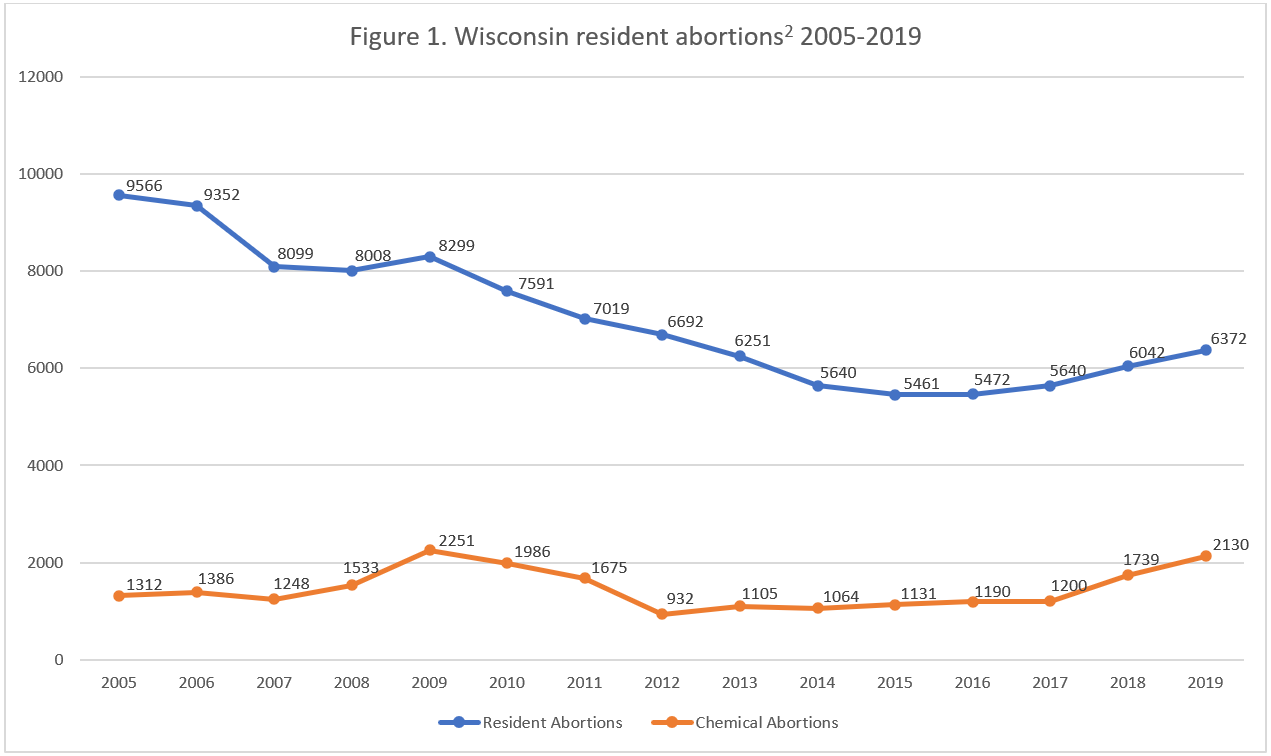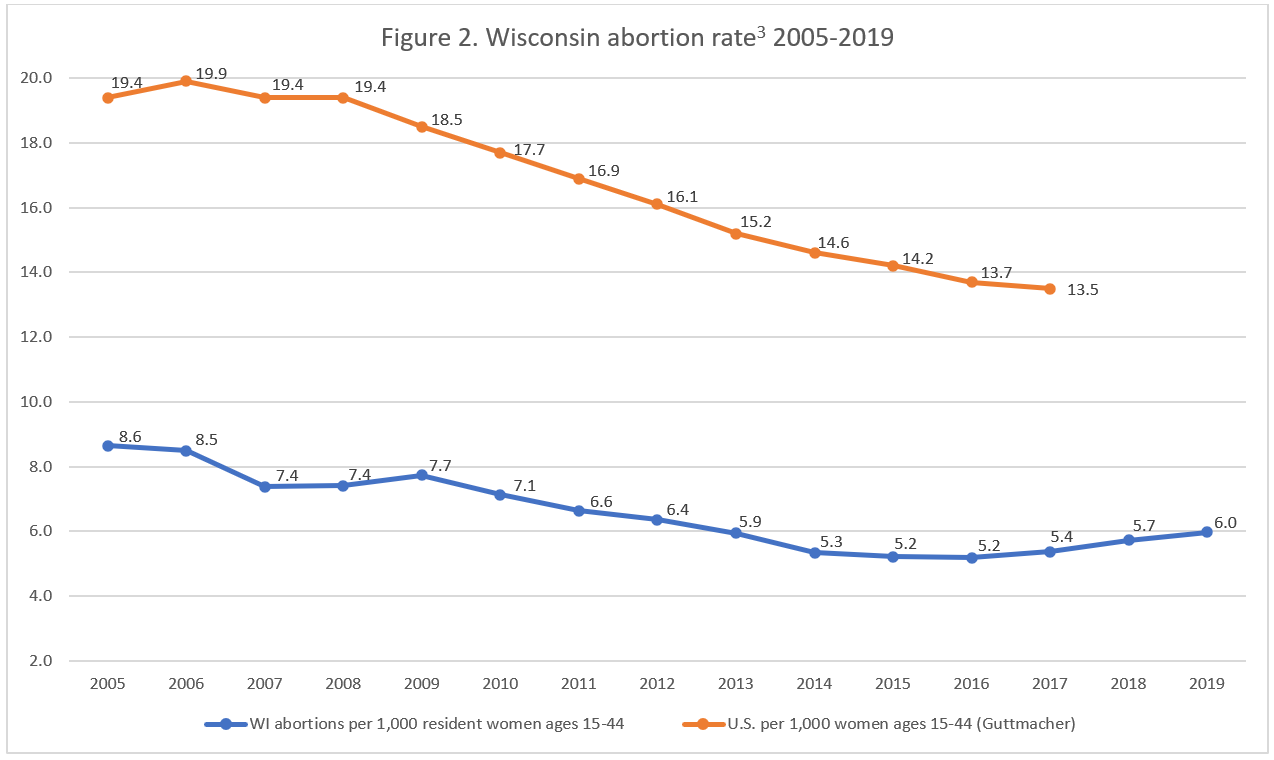Abortion Reporting: Wisconsin (2019)
Wisconsin’s 2019 abortion report was released in January 2021, showing that abortions in the Badger State increased for the third year in a row. As of August 2021, 38 states had released 2019 abortion statistics; 21 of these states reported that abortions had increased from the previous year.
Changes in Wisconsin Abortions, 2018-2019

*The change in total abortions and chemical abortions reflects abortions performed on Wisconsin residents. The change in the abortion rate reflects all abortions reported in Wisconsin, including nonresidents. The report does not include information on Planned Parenthood’s Wisconsin abortion market share.
Abortion Totals and Trends
Wisconsin reported 6,511 abortions in 2019, up five percent from the year before. Of these, 6,372 were performed on Wisconsin residents, including 2,165 chemical abortions (Fig. 1). Chemical abortions performed on Wisconsin residents increased by 22 percent, making up 33 percent of Wisconsin resident abortions in 2019. If chemical abortions completed surgically are included in the chemical abortion total, chemical abortions increased by over 24%. The Charlotte Lozier Institute (CLI) estimates that Wisconsin’s abortion rate was lower than the national rate at 6.0 abortions per 1,000 women ages 15 to 44 (Fig. 2).
State Report Summary
In 2019, 98 percent of the abortions occurring in Wisconsin were performed on Wisconsin residents, while two percent were obtained by nonresident women. Three percent of the abortions were on girls under the age of 18, and eight percent were on girls ages 18 to 19. Twenty-nine percent were performed on women ages 20 to 24, 28 percent were performed on women ages 25 to 29, and another 28 percent were performed on women in their thirties. Four percent were performed on women age 40 or older.
There were 195 abortions performed on Wisconsin residents under the age of 18. Fewer than five were emancipated minors. Five minors obtained judicial waivers to Wisconsin’s parental consent requirement, and 187 minors had adults provide consent on their behalf. Of these 187 cases, 176 had consent provided by a parent, and 11 had consent provided by a different adult family member.
Just over half the abortions, 51 percent, were on white women. Twenty-eight percent were performed on black women, and four percent were on women of Asian or Pacific Islander descent. One percent of the abortions were on Native American women, and two percent were on women of multiple races. Thirteen percent were on women of other or unknown races. Eighty-eight percent of the abortions were on non-Hispanic women, 12 percent were on Hispanic women, and not quite one percent were on women of unreported ethnicity.
A large majority of the abortions (86 percent) were on unmarried women, 13 percent were on married women, and one percent were on women of unknown marital status. Eight percent of the abortions were obtained by women with fewer than 12 years of education. Thirty-nine percent were on women with 12 years, and 36 percent were on women with 13 to 15 years, while 16 percent were performed on women with 16 years of education or more. Level of education was not reported for one percent.
More than half the abortions (58 percent) occurred at eight weeks of gestation or earlier. Nineteen percent were performed between nine and 10 weeks, and nine percent occurred from 11 to 12 weeks of gestation. Seven percent were performed from 13 to 15 weeks, and six percent from 16 to 20 weeks. There were 60 abortions, almost one percent, performed after 20 weeks of gestation. Unless in cases of medical emergency, abortion in Wisconsin is limited at 20 weeks post-fertilization, around 22 weeks of gestation. The report cautions that gestational age data can be inconsistent and imprecise; some providers report the length of pregnancy from the woman’s last menstrual period, while other providers provide an estimate of gestational age.
Information on the types of abortion procedures used is provided for abortions performed on Wisconsin residents only. Of the abortions performed on Wisconsin women, 66 percent were performed using surgical procedures, and 33 percent were chemical abortions. In addition, there were 35 failed or incomplete chemical abortions that were completed surgically; the Wisconsin Department of Health Services told CLI that there is no way of determining whether any of these incomplete abortions were also separately reported as chemical abortions. If these incomplete chemical abortions were double-counted, they would slightly inflate Wisconsin’s 2019 abortion total.
In 2019, 89 percent of the abortions were reported to have no complications.1 Multiple complications can be reported for each abortion, and the most commonly reported complication was retained products of conception, occurring 621 times (a dramatic difference from 73 the previous year). Cervical lacerations occurred 54 times (an increase from two in 2018). There were five cases of hemorrhage, four uterine perforations, and three infections. Additionally, there were 552 other, unspecified complications. The report acknowledges the possibility that “some complications are missed or misreported.”
Abortion complications in Wisconsin are reported by the abortion center; there is no requirement for emergency departments or other medical providers to report abortion complications they treat. The report does not indicate why retained products of conception and cervical lacerations increased from the previous year. However, Planned Parenthood, which operates three abortion centers in Wisconsin, extended the time frame in which it performs chemical abortions by an additional week in 2019 (from 10 weeks 0 days to 11 weeks 0 days). The failure rate of chemical abortions increases with advancing gestational age, which may have contributed to the uptick in cases of retained products.
Planned Parenthood’s Lawsuit
Planned Parenthood is challenging several aspects of Wisconsin abortion law, including the stipulation that only physicians are permitted to perform abortions, that the doctor who conducts a pre-abortion medical examination must also be the doctor to dispense the abortion pills, and that the abortion pills must be dispensed in person (rather than via telemedicine). Planned Parenthood claims that without these requirements, 25 of its advanced practice nurses could perform abortions, and chemical abortions could be initiated at all its Wisconsin centers via telemedicine. The trial concluded in December 2020.
State Ranking
In 2016, CLI evaluated abortion reporting in the 50 states, New York City, and the District of Columbia, and Wisconsin’s reporting was tied for 17th best. To improve its reporting, Wisconsin could report abortion procedures with more specificity, such as specifying whether a surgical abortion was performed using suction aspiration (a common first-trimester method) or dilation and evacuation (commonly used in the second trimester). Wisconsin could also indicate whether complications resulted from chemical or surgical abortions. In addition, Wisconsin could add a check box to its abortion reporting form that would allow the person filling out the form to indicate whether this procedure was completing a chemical abortion that had already been reported. Wisconsin could amend its abortion reporting form to allow providers to indicate whether they reported weeks LMP or estimated the length of the pregnancy.


-
- Statistics on abortion complications reported here represent a minimal number of deaths and complications, as this data is collected in a non-systematic and non-verifiable way. As such, this data cannot be used to calculate either an accurate abortion mortality rate or an accurate abortion complication rate for the state. The report cautions that “Assessing the incidence of complications is somewhat problematic. Some complications do not occur immediately or become apparent while the patient is in post-procedure recovery, Therefore [sic] some complications are missed or misreported.”
- Because the Wisconsin Department of Health Services is unable to tell whether an incomplete chemical abortion was previously reported as a chemical abortion, these incomplete abortions are not included in the chemical abortion totals. Consequently, chemical abortion totals depicted here differ from those reported in previous articles.
- Rates were calculated by CLI using the following formula: (total number of abortions performed in Wisconsin ÷ number of resident women ages 15-44) x 1,000. Rates may differ slightly from previous CLI articles due to revised population estimates. Population estimates were obtained from the CDC WONDER database.
Click here to view reporting from:2023202220212020201820172016




























